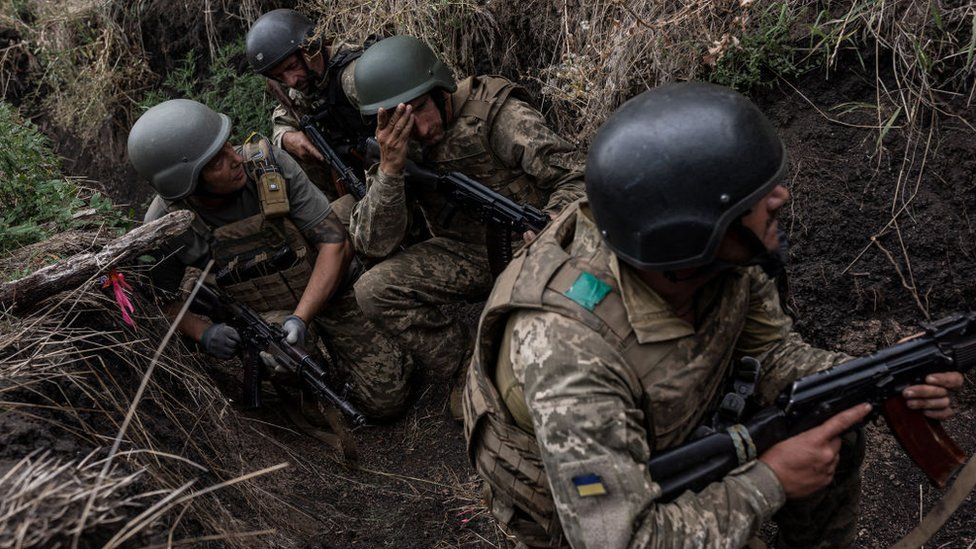Ukraine’s generals say they have “broken through” Russia’s first line of defence in the south.
We’ve assessed how far Ukrainian forces have really progressed, and what signs there are of further breakthroughs along the frontline.

Ukraine began its big counter-offensive in early June to push Russian forces back from land they seized. It attacked at three points along the 600-mile-plus (965km) frontline.
The area to the south-east of the city of Zaporizhzhia is by far the most strategically important.
Striking out in this direction towards the Sea of Azov, if successful, could cut off Russia’s supply lines that connect the Russian city of Rostov-on-Don to Crimea.
There hasn’t been much progress on this front, except for the area around the villages of Robotyne and Verbove in the Zaporizhzhia region, as seen highlighted in purple in the map above.
If Ukraine can sever this main supply route then Russia will find it all but impossible to maintain its huge garrison in Crimea which it annexed in 2014.
Despite significant obstacles, there are now confirmed sightings of Ukrainian troops breaching Russia’s defensive structures along the southern front.
We have verified nine social media videos along the frontline near Verbove.

Four of the videos show Ukrainian forces breaching Russian defences north of Verbove.
However, these show incursions, not that Ukraine has managed to take control of the area.
So far it has only been Ukrainian infantry getting through, and we’re not seeing Ukrainian armoured columns pouring through, exploiting the gap and holding the ground taken.
What is stopping Ukraine advancing faster?
Moscow saw this counter attack coming long ago and has spent months building the world’s most formidable layered defences in depth.
This is what they look like from space – lines of interlocking obstacles, trenches, bunkers and minefields, each covered by artillery.
Vast minefields have slowed the Ukrainian advance.
These minefields are intensely packed, in some places up to five mines laid in a square metre.
Your device may not support this visualisation
Ukraine’s first attempt to charge through them in June quickly ended in failure, with its modern, Western-supplied armour crippled and burning. Ukrainian infantry came similarly unstuck, taking horrific casualties.
Kyiv has since had to resort to clearing these mines on foot, often at night and sometimes under fire. Hence the slow progress to date.
Ukraine’s tanks and armoured vehicles are vulnerable to Russia’s mines, drones and anti-tank missiles – like in this video analysed by BBC Verify which shows a British-supplied Challenger 2 tank that got hit near Robotyne.
This video can not be played
To play this video you need to enable JavaScript in your browser.
These will only be able to push forward in numbers once a sufficiently wide path has been cleared through the minefields and when Russian artillery there has been subdued.
What next for Ukraine’s counter-offensive?
“The problem that the Ukrainians have now”, says Dr Marina Miron at King’s College London War Studies Department, “is to get an opening big enough to get more troops in”.
Meanwhile Russia has been moving in reinforcements, and this battlefront is dynamic, it’s moving, and Russia could still reverse Ukraine’s gains.
We’ve geolocated a Russian drone video which backs up reports that its elite airborne forces, the VDV, have deployed close to the town of Verbove – a move aimed at plugging any gaps created by Ukraine’s counter-offensive.
“Ukrainian forces continue to face resistance from Russian forces on the battlefield,” says Kateryna Stepanenko, Russia analyst at the London-based think tank, RUSI.
“Alongside artillery fire, drone strikes and Russian defensive structures – Russian forces are also extensively using electronic warfare measures that aim to impede Ukrainian signals and drone usage.”
Ukraine has barely progressed more than 10% of the way to the coast, but the reality is much more nuanced than that.

Russia’s forces are exhausted and possibly demoralised after sustaining three months of intensive attacks, including long-range strikes that are targeting their supply lines.
If Ukraine can break through the remaining Russian defences and reach as far as the town of Tokmak then this would bring Russia’s rail and road supply routes for Crimea within range of its artillery.
If they can do that, then this counter offensive can be judged a qualified success.
It may not end the war, which is likely to drag on well into 2024 and perhaps longer – but it would seriously undermine Moscow’s war effort and put Ukraine in a strong position for when peace talks eventually begin.
But for Kyiv, the clock is ticking. The rainy season will arrive within weeks, turning the roads to mud and hindering further advances.
Beyond that lies the uncertainty of the US presidential elections, where a Republican victory could see US military support for Ukraine dramatically slashed.
President Putin knows he needs to tough it out until then. The Ukrainians know they have got to make this counter-offensive succeed.
Reporting by Jake Horton, Paul Brown, Benedict Garman, Daniele Palumbo, Olga Robinson.
Graphics by Tural Ahmedzade, Mark Bryson, Erwan Rivault.


